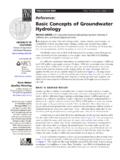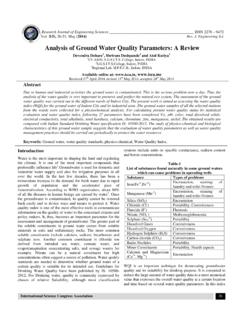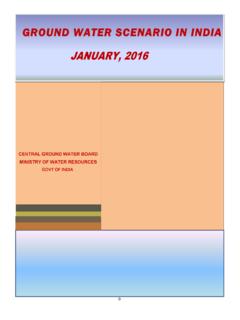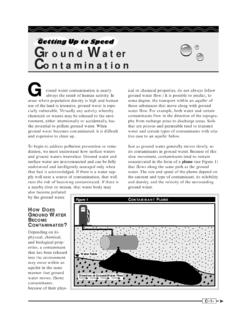Transcription of GROUND WATER - WHO | World Health …
1 Chapter 3 GROUND WATER I Engineering and Geological Considerations GROUND WATER serves the great majority of people who live in rural areas and have a WATER -supply system of one type or another. The reason is 1 that, among the various sources of supply, GROUND WATER is by far the most I practical and safe in nature. Even in a highly industrialized country such as the USA, municipal GROUND - WATER installations far outnumber surface- WATER supplies. It is very probable that, for a long time to come, GROUND WATER will be the most important source of supply for most rural communi- ties of the World . The advantages of GROUND WATER are : (I) it is likely to be free of pathogenic bacteria; (2) generally, it may be used without further treatment; (3) in many instances it can be found in the close vicinity of rural I I / comnlunities ; (4) it is often most practical and economical to obtain and distribute; (5) the WATER -bearing stratum from which it is drawn usually provides a natural storage at the point of intake.
2 The disadvantages are : (1) GROUND WATER is often high in mineral content; (2) it usually requires pumping. In GROUND - WATER -supply investigations and design, the engineer is con- cerned with the following steps : (1) to find it in the required quantity and quality as near as possible I I to the centre of consumption, in order to reduce transport costs ; 1 (2) to extract it by means of a system which produces the quantity I required, safeguards the quality, and, at the same time, involves the least I capital outlay ; (3) to transport the WATER to the consumer in a way which requires the least amount of operational and maintenance skill and cost. This section is concerned chiefly with the first step mentioned above. Obviously, a rural town or village cannot afford the cost involved in bringing WATER long distances by gravity or, much less, by pumpmg. The 58 WATER SUPPLY FOR RURAL AREAS WATER which will serve a rural community must therefore be found within a rather limited area.
3 A brief discussion regarding the occurrence of GROUND WATER and the characteristics of underground formations from which it can be extracted may be valuable to the designing engineer. Fig. 4. GEOLOGICAL FORMATIONS 1 = Areas where there are good possibilities of obtaining WATER from infiltration galleries, well-poinl systems 2 = GROUND WATER is outcropping at this point, so that a flowing spring is formed. At the foot of rivet banks and hills other springs may possibly be found. 3 = Top of GROUND - WATER table 4 = Area of infiltration to supply formation B A = Non-confined (non-artesian), WATER -bearing formation covered with top soil B = Confined (artesian), WATER -bearing formation C = Impervious rock, or hard-pan formation To supply a village situated along the banks of the main river in this rolling country with a good grounc WATER table, the first thing to look for is a spring above the town that could be developed and would flow b) gravity. If no springs were found within a reasonable distance above the point of consumption, some migh~ be found outcropping near the stream bed.
4 If no springs were found within a reasonable distance, any we1 penetrating formation A would produce WATER . If large quantities were required, a well-point system or ; gallery at points indicated would probably work. A deep well, properly constructed and developed, pene. trating formation B would probably produce considerable WATER . The engineer making a survey of this area, knowing what is shown in this figure, ought to follow a pro. cedure such as described above. I ZONE OF .INTERCONNECTED OPENINGS I VARIETIES OCCURRING THROUGHOUT ZONE OF SUSPENDED WATER z :z SATURATED ZONE GROUND WATER (PHREATIC WATER ) UNDERSATURATED ZONE (ZONE OF AERATION) SUSPENDED WATER 60 WATER SUPPLY FOR RURAL AREAS Fig. 6. COMPARISON OF FREE AND CONFINED GROUND WATER BC = theoretical static level of contined WATER body BC' = pressure gradient; indicates actual static level in wells piercing the conduit Reproduced from Tolman, C. F. (1937) GROUND WATER , p. 55, by kind permission of McGraw-Hill Book Co.
5 , Inc., New York Occurrence GROUND WATER is that portion of the atmospheric precipitation, mostly rainfall, which has percolated into the earth to form underground deposits called aquifers ( WATER -bearing formations) ( see Fig. 4 ). These can be tapped by various means, to be discussed later; and, in the great majority of cases, they can be used without further treatment for individual and com- munity WATER -supplies in rural areas. Fig. 5 shows the occurrence and distribution of subsurface WATER . The great majority of wells for rural WATER -supplies take WATER from the zone which Tolman 35 defines as the " free- WATER zone " (Fig. 5, 6). These will usually be jetted, dug, driven, or bored wells. Infiltration gal- leries also take WATER from this zone. Drilled wells often penetrate the confined WATER aquifer. It is from this stratum that flowing wells are developed. The aquifer must be supplied with an ample quantity of WATER if it is to serve as a source.
6 It is simply a reservoir and can be depleted in the same manner as a surface reservoir if its supply is inferior to the demand placed on it. In rural areas this is very seldom a concern as the aquifer will usually be replenished sufficiently to supply the relatively small demands of rural communities. An element of greater significance for the engineer INSTALLATION OF WATER -SUPPLY SYSTEMS 6 1 searching for GROUND WATER pertains to the characteristics of the soil form- ation of the aquifer, , to the ability of the aquifer to give up WATER and, therefore, to serve as a reliable source of supply. The quantity of WATER that can be extracted from an aquifer will depend on (1) its porosity and permeability, and (2) the draw-down in the well. The porosity and the permeability of a formation are limited by nature; and, while gravel packing a may alter conditions somewhat in the imme- diate vicinity of a well intake, the general nature of the aquifer is fixed and Fig.
7 7. SHALLOW WELL IN FREE- WATER ZONE P A = GROUND surface B = Top layers of soil C = WATER -bearing stratum D = Impervious stratum E = Thickness of WATER -bearing stratum F = WATER table WHO 8296 b G = Draw-down H = Depth of penetration of well into aquifer I = Draw-down cone J = Curve of maximum draw-down P = Pump R = Radius of circle of influence a Gravel packing is the development of a pocket of coarse, graded sand and gravel around a well intake- pipe to exclude fine sand and improve entrance velocity of WATER into the pipe. 62 WATER SUPPLY FOR RURAL AREAS cannot be modified. The draw-down in a well, however, can be varied within the limits of the thickness of the aquifer, the penetration of the well into the aquifer, and the capacity of the pump used (see Fig. 7, 8). Fig. 8. WELL TAPPING CONFINED WATER P wno 82*6 a A = GROUND surface F = WATER table C = WATER -bearing stratum G = Draw-down D = Impervious stratum I = Draw-down cone E = Thickness of WATER -bearing Q = Depth of WATER in well stratum R = Radius of circle of influence The porosity of a formation is the pore space between the particles which make up the formation.
8 It is the volume of the voids. Obviously, a solid piece of dense rock will have low porosity-a low volume of pore space or voids. If many pieces of stone of varying shapes and sizes replace the single piece of the same total volume, the porosity will increase since the voids are increased. Steel 32 gives the following figures regarding the porosity of common soils and rocks : sands and gravels of fairly uniform size and moderately compacted, 35 %-40%; well-graded and compacted sands and gravels, 25 %-30 %; sandstone, 4 %-30 %; chalk, 14 %-45 %; granite, schist, INSTALLATION OF WATER -SUPPLY SYSTEMS 63 and gneiss, %-2 %; slate and shale, %-8 %; limestone, %-17 %; clay, 44 %-47 %; topsoils, 37 %-65 %. Fair & Geyer l6 report that silts may be as high as 80 % in porosity. It can be seen that soils with fine, separate particles, such as clay, topsoil, and silt, have a very high porosity. In other words, they have a big volume in which WATER can be stored.
9 GROUND formations, however, have a certain tendency to hold the WATER and to give up only a part of it. This characteristic of a soil formation is called permeability; it is the quality of a formation which controls the passage of WATER through it. From a knowledge of hydraulics, it is obvious that WATER will pass through large openings more easily than it does through small ones. Clays and topsoils have high porosity (large volume of voids) but low permeability (very small opening between particles), so that WATER passes through them with great difficulty. Gravels and sands, on the other hand, are permeable and therefore allow GROUND WATER to pass with relative ease. This type of formation is also porous, as can be seen above, so that it can store large quantities of WATER . These, then, are the WATER -bearing for- mations most amenable to the development of wells and most important to the engineer in searching for a rural community WATER -supply.
10 Sandstone is both porous and pervious and therefore an excellent aquifer which can be tapped to produce large quantities of WATER , especially if it is confined as shown in Fig. 4 (formation B) and Fig. 5 (see pages 58 and 59). Where it is known, for example, that sandstone underlies an area, and where no other readily available source is found, a test hole into this stratum would be a good risk. Chalk formations in the British Isles and in Haiti are known to produce reasonable quantities of WATER . Except for unusual geological features or underground dams, it can be said that, in any drainage basin, GROUND WATER always flows towards the principal streams (Fig. 4). While there are exceptions to this rule, the best place to look for shallow GROUND - WATER is at the bottom of draws and valleys. It is in this area that pockets of sand and gravel may have been deposited. If these are close to the present stream or in an old course, they will pro- bably be well supplied.
















